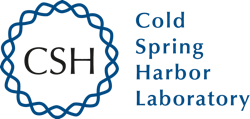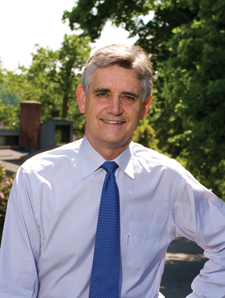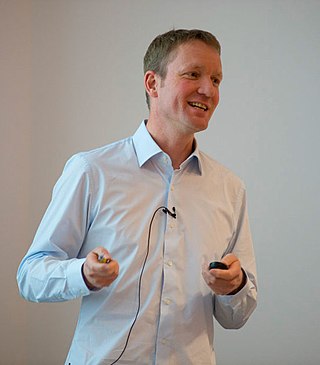Related Research Articles

James Dewey Watson is an American molecular biologist, geneticist, and zoologist. In 1953, he co-authored with Francis Crick the academic paper proposing the double helix structure of the DNA molecule. Watson, Crick and Maurice Wilkins were awarded the 1962 Nobel Prize in Physiology or Medicine "for their discoveries concerning the molecular structure of nucleic acids and its significance for information transfer in living material".

Cold Spring Harbor Laboratory (CSHL) is a private, non-profit institution with research programs focusing on cancer, neuroscience, plant biology, genomics, and quantitative biology.

Sir Gregory Paul Winter is a Nobel Prize-winning English molecular biologist best known for his work on the therapeutic use of monoclonal antibodies. His research career has been based almost entirely at the MRC Laboratory of Molecular Biology and the MRC Centre for Protein Engineering, in Cambridge, England.
Suzanne Cory is an Australian molecular biologist. She has worked on the genetics of the immune system and cancer and has lobbied her country to invest in science. She is married to fellow scientist Jerry Adams, also a WEHI scientist, whom she met while studying for her PhD at the University of Cambridge, England.

Sir David Charles Baulcombe is a British plant scientist and geneticist. As of 2017 he is a Royal Society Research Professor. From 2007 to 2020 he was Regius Professor of Botany in the Department of Plant Sciences at the University of Cambridge.
Brigid L. M. Hogan FRS is a British developmental biologist noted for her contributions to mammalian development, stem cell research and transgenic technology and techniques. She is currently a Professor in the Department of Cell Biology at Duke University, Born in the UK, she became an American citizen in 2000.

Bruce William Stillman, AO, FAA, FRS is a biochemist and cancer researcher who has served as the Director of Cold Spring Harbor Laboratory (CSHL) since 1994 and President since 2003. He also served as the Director of its NCI-designated Cancer Center for 25 years from 1992 to 2016. During his leadership, CSHL has been ranked as the No. 1 institution in molecular biology and genetics research by Thomson Reuters. Stillman's research focuses on how chromosomes are duplicated in human cells and in yeast Saccharomyces cerevisiae; the mechanisms that ensure accurate inheritance of genetic material from one generation to the next; and how missteps in this process lead to cancer. For his accomplishments, Stillman has received numerous awards, including the Alfred P. Sloan, Jr. Prize in 2004 and the 2010 Louisa Gross Horwitz Prize, both of which he shared with Thomas J. Kelly of Memorial Sloan-Kettering Cancer Center, as well as the 2019 Canada Gairdner International Award for biomedical research, which he shared with John Diffley.

Sir Shankar Balasubramanian is an Indian-born British chemist and Herchel Smith Professor of Medicinal Chemistry in the Department of Chemistry at the University of Cambridge, Senior Group Leader at the Cancer Research UK Cambridge Institute and Fellow of Trinity College, Cambridge. He is recognised for his contributions in the field of nucleic acids. He is scientific founder of Solexa and Cambridge Epigenetix.
Simon Tavaré is the founding Director of the Herbert and Florence Irving Institute of Cancer Dynamics at Columbia University. Prior to joining Columbia, he was Director of the Cancer Research UK Cambridge Institute, Professor of Cancer Research at the Department of Oncology and Professor in the Department of Applied Mathematics and Theoretical Physics (DAMTP) at the University of Cambridge.
Robert Anthony Martienssen is a British plant biologist, Howard Hughes Medical Institute–Gordon and Betty Moore Foundation investigator, and professor at Cold Spring Harbor Laboratory, US.
John Tooze FRS was a British research scientist, research administrator, author, science journalist, former executive director of EMBO/EMBC, director of research services at the Cancer Research UK London Research Institute and a vice president at The Rockefeller University.

Scott William Lowe is Chair of the Cancer Biology and Genetics Program in the Sloan Kettering Institute at Memorial Sloan Kettering Cancer Center. He is recognized for his research on the tumor suppressor gene, p53, which is mutated in nearly half of cancers.

Anne Jacqueline Ridley is professor of Cell Biology and Head of School for Cellular and Molecular Medicine at the University of Bristol. She was previously a professor at King's College London.

Jan Löwe is a German molecular and structural biologist and the Director of the Medical Research Council (MRC) Laboratory of Molecular Biology (LMB) in Cambridge, UK. He became Director of the MRC-LMB in April 2018, succeeding Sir Hugh Pelham. Löwe is known for his contributions to the current understanding of bacterial cytoskeletons.

Richard Malcolm Marais is Director of the Cancer Research UK (CRUK) Manchester Institute and Professor of Molecular Oncology at the University of Manchester.

Sir Richard Henry Treisman is a British scientist specialising in the molecular biology of cancer. Treisman is a director of research at the Francis Crick Institute in London.
Leemor Joshua-Tor is the W.M. Keck Professor of Structural Biology at Cold Spring Harbor Laboratory and a Howard Hughes Medical Institute Investigator. Her research focuses on the role of the argonaute complex in RNA interference.
Professor Jason Carroll is a British medical researcher serving as a Senior Group Leader at the Cancer Research UK Cambridge Institute, University of Cambridge and Founder and Chief Scientific Officer of Azeria Therapeutics. He is a Professor of Molecular Oncology assigned to the Department of Oncology and a Fellow of Clare College, Cambridge.
Caetano Maria Pacheco Pais dos Reis e Sousa is a senior group leader at the Francis Crick Institute and a professor of Immunology at Imperial College London.

M. Madan Babu is an Indian-American computational biologist and bioinformatician. He is the endowed chair in biological data science and director of the center of excellence for data-driven discovery at St. Jude Children’s Research Hospital. Previously, he served as a programme leader at the MRC Laboratory of Molecular Biology (LMB).
References
- ↑ Greg Hannon's ORCID 0000-0003-4021-3898
- ↑ Gregory Hannon at Library of Congress
- 1 2 "Greg Hannon – Hannon Laboratory". hannonlab.org. Retrieved 20 June 2018.
- ↑ "Find people in the EMBO Communities". people.embo.org. Retrieved 20 June 2018.
- ↑ "Gregory Hannon". royalsociety.org. Retrieved 20 June 2018.
- 1 2 3 4 5 6 Gregory Hannon publications indexed by Google Scholar
- ↑ "Gregory J. Hannon, PhD - HHMI.org".
- ↑ Hannon, Gregory James (1992). Trans-splicing of nematode pre-messenger RNA (PhD thesis). Case Western Reserve University. OCLC 29529734. ProQuest 304045738.
- 1 2 3 4 5 6 7 Anon (2018). "Professor Gregory Hannon FRS". royalsociety.org. London: Royal Society. One or more of the preceding sentences incorporates text from the royalsociety.org website where:
“All text published under the heading 'Biography' on Fellow profile pages is available under Creative Commons Attribution 4.0 International License.” -- "Terms, conditions and policies | Royal Society". Archived from the original on 2016-11-11. Retrieved 2018-06-20.
{{cite web}}: CS1 maint: bot: original URL status unknown (link) - ↑ "Professor Greg Hannon leads £20 million Grand Challenge project to build 3D cancer tumour". 10 February 2017.
- ↑ "Professor Greg Hannon appointed new Director of Cancer Research UK Cambridge Institute". 17 November 2017.
- ↑ "Hannon Lab @ New York Genome Center". nygenome.org. Retrieved 20 June 2018.
- ↑ "Hannon Laboratory @CSHL". hannonlab.cshl.edu.
- ↑ Gregory Hannon publications indexed by the Scopus bibliographic database. (subscription required)
- ↑ Gregory Hannon publications from Europe PubMed Central
- ↑ Hannon, Gregory J. (2002). "RNA interference". Nature. 418 (6894): 244–251. Bibcode:2002Natur.418..244H. doi:10.1038/418244a. ISSN 0028-0836. PMID 12110901. S2CID 4426281.

- ↑ Bernstein, Emily; Caudy, Amy A.; Hammond, Scott M.; Hannon, Gregory J. (2001). "Role for a bidentate ribonuclease in the initiation step of RNA interference". Nature. 409 (6818): 363–366. Bibcode:2001Natur.409..363B. doi:10.1038/35053110. ISSN 0028-0836. PMID 11201747. S2CID 4371481.

- ↑ Murchison, Elizabeth P.; Hannon, Gregory J. (2004). "miRNAs on the move: miRNA biogenesis and the RNAi machinery". Current Opinion in Cell Biology. 16 (3): 223–9. doi:10.1016/j.ceb.2004.04.003. PMID 15145345.

- ↑ cancergrandchallenges.org/teams/imaxt
- ↑ Kaiser, Jocelyn (2017-02-09). "U.K. cancer charity awards £71 million for four major research challenges". Science | AAAS. Retrieved 2019-08-28.
- ↑ "Cancer Research UK announces four 'Grand Challenge' teams". www.timeshighereducation.com. 10 February 2017. Retrieved 2019-08-28.
- ↑ Walsh, Fergus (2018-12-26). "'Virtual tumour' new way to see cancer" . Retrieved 2019-08-28.
- 1 2 Salter, Jessica (2019-07-29). "Researchers are using virtual reality in the fight against cancer". The Telegraph. ISSN 0307-1235 . Retrieved 2019-08-28.
- ↑ "Cancer Research UK and AstraZeneca launch world class functional genomics centre". Cancer Research UK. 2018-12-10. Retrieved 2019-08-28.
- ↑ "AstraZeneca and CRUK launch Cambridge centre to accelerate cancer drug development". Cambridge Independent. 2018-12-10. Retrieved 2019-08-28.
- ↑ "Gregory J. Hannon, Ph.D." pew.org. Retrieved 2019-08-28.
- ↑ "Gregory J. Hannon". Rita Allen Foundation. August 10, 2016. Retrieved 2019-08-28.
- ↑ "Press Release: Innovator Award Recipients from the DOD Breast Cancer Research Program; Congressionally Directed Medical Research Programs (CDMRP)". cdmrp.army.mil. Retrieved 2019-08-28.
- ↑ "Greg Hannon awarded the 2005 AACR Award for Outstanding Achievement in Cancer Research". Cold Spring Harbor Laboratory. 2005-04-27. Retrieved 2019-08-28.
- ↑ "AACR Award for Outstanding Achievement in Cancer Research". www.aacr.org. Archived from the original on 2019-08-28. Retrieved 2019-08-28.
- ↑ "CSHL molecular biologist honored by National Academy of Sciences". Cold Spring Harbor Laboratory. 2007-01-17. Retrieved 2019-08-28.
- ↑ "2007 Prize Winners". Memorial Sloan Kettering Cancer Center. Retrieved 2019-08-28.
- ↑ "Paul Marks Prize Recognizes Three Young Cancer Researchers". Memorial Sloan Kettering Cancer Center. September 26, 2007. Retrieved 2019-08-28.
- ↑ "CSHL Professor Gregory Hannon elected to U.S. National Academy of Sciences". Cold Spring Harbor Laboratory. 2012-05-01. Retrieved 2019-08-28.
- ↑ "Gregory Hannon". www.nasonline.org. Retrieved 2019-08-28.
- 1 2 "Gregory Hannon | Royal Society". royalsociety.org. Retrieved 2019-08-28.
- ↑ "Professor Gregory Hannon | The Academy of Medical Sciences". acmedsci.ac.uk. Retrieved 2019-08-28.
- ↑ "The Academy of Medical Sciences announces new Fellows for 2017". University of Cambridge. 2017-05-08. Retrieved 2019-08-28.
- ↑ "Find people in the EMBO Communities". people.embo.org. Retrieved 2019-08-28.
- ↑ "Prof Greg Hannon elected to EMBO Membership". Cancer Research UK Cambridge Institute. 2018-05-14. Retrieved 2019-08-28.
- ↑ "Fellows| European Academy of Cancer Sciences". www.europeancanceracademy.eu. Archived from the original on 2019-07-04. Retrieved 2019-11-13.
- ↑ "AACR Announces Fellows of the AACR Academy Class of 2020 | AACR | News Releases". American Association for Cancer Research (AACR). Retrieved 2020-06-05.
![]() This article incorporates text available under the CC BY 4.0 license.
This article incorporates text available under the CC BY 4.0 license.